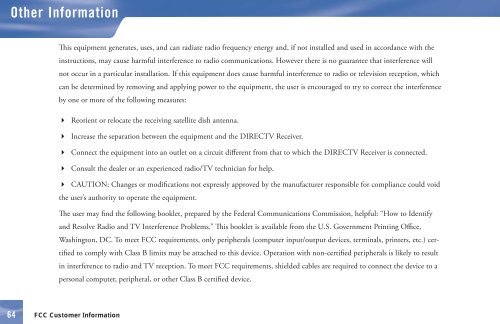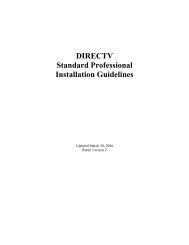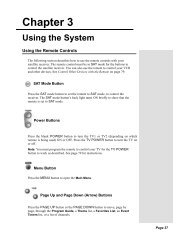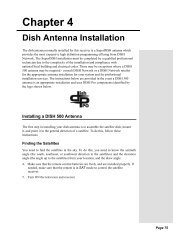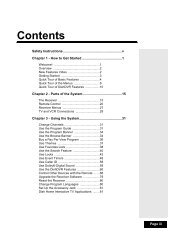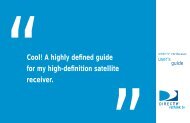DIRECTV® Receiver User Guide (D11) - DBSInstall.com
DIRECTV® Receiver User Guide (D11) - DBSInstall.com
DIRECTV® Receiver User Guide (D11) - DBSInstall.com
You also want an ePaper? Increase the reach of your titles
YUMPU automatically turns print PDFs into web optimized ePapers that Google loves.
Other Information<br />
This equipment generates, uses, and can radiate radio frequency energy and, if not installed and used in accordance with the<br />
instructions, may cause harmful interference to radio <strong>com</strong>munications. However there is no guarantee that interference will<br />
not occur in a particular installation. If this equipment does cause harmful interference to radio or television reception, which<br />
can be determined by removing and applying power to the equipment, the user is encouraged to try to correct the interference<br />
by one or more of the following measures:<br />
4 Reorient or relocate the receiving satellite dish antenna.<br />
4 Increase the separation between the equipment and the DIRECTV <strong>Receiver</strong>.<br />
4 Connect the equipment into an outlet on a circuit different from that to which the DIRECTV <strong>Receiver</strong> is connected.<br />
4 Consult the dealer or an experienced radio/TV technician for help.<br />
4 CAUTION: Changes or modifications not expressly approved by the manufacturer responsible for <strong>com</strong>pliance could void<br />
the user’s authority to operate the equipment.<br />
The user may find the following booklet, prepared by the Federal Communications Commission, helpful: “How to Identify<br />
and Resolve Radio and TV Interference Problems.” This booklet is available from the U.S. Government Printing Office,<br />
Washington, DC. To meet FCC requirements, only peripherals (<strong>com</strong>puter input/output devices, terminals, printers, etc.) certified<br />
to <strong>com</strong>ply with Class B limits may be attached to this device. Operation with non-certified peripherals is likely to result<br />
in interference to radio and TV reception. To meet FCC requirements, shielded cables are required to connect the device to a<br />
personal <strong>com</strong>puter, peripheral, or other Class B certified device.<br />
64<br />
FCC Customer Information


